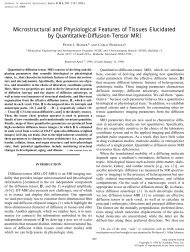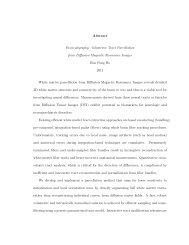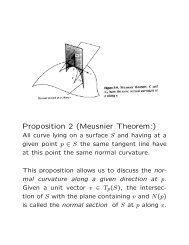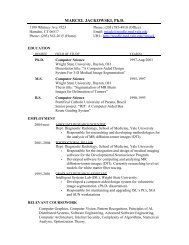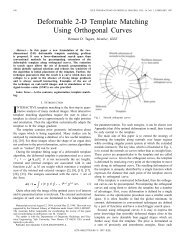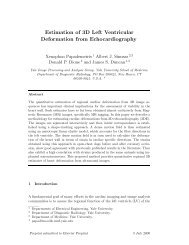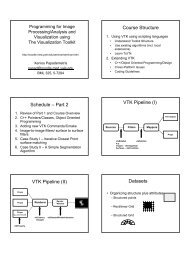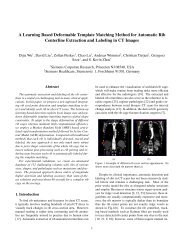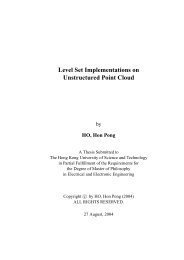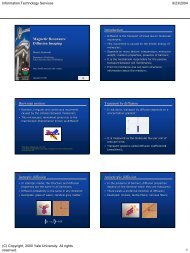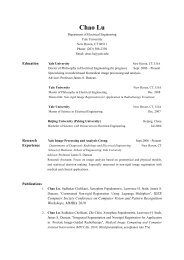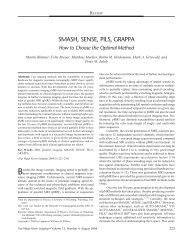Pulsed-field gradient nuclear magnetic resonance as a tool for ...
Pulsed-field gradient nuclear magnetic resonance as a tool for ...
Pulsed-field gradient nuclear magnetic resonance as a tool for ...
You also want an ePaper? Increase the reach of your titles
YUMPU automatically turns print PDFs into web optimized ePapers that Google loves.
302<br />
PRICE<br />
allows diffusion to be added to the standard NMR<br />
observables of chemical shifts and relaxation times<br />
Ži.e., longitudinal or T 1; transverse or T 2;<br />
and in<br />
the rotating frame or T . 1 . Gradient-b<strong>as</strong>ed diffusion<br />
me<strong>as</strong>urements have been found to have clinical<br />
utility in NMR imaging studies Ž 4549. especially<br />
in regard to study of cerebral ischaemia<br />
e.g., Ref. Ž 50. and references therein .<br />
The aim of this article is to present an introduction<br />
to the PFG experiment and the theoretical<br />
b<strong>as</strong>is used <strong>for</strong> interpreting the data, to determine<br />
the diffusion coefficient of a probe species<br />
and perhaps in<strong>for</strong>mation on the geometry in which<br />
it is diffusing. As it is not possible to provide a<br />
comprehensive review of the literature in a single<br />
paper, a number of pertinent references have<br />
been mentioned in the text that may be consulted<br />
<strong>for</strong> more in-depth coverage of some <strong>as</strong>pects. The<br />
analysis of PFG NMR experiments is inherently<br />
mathematical, and general books on mathematical<br />
methods e.g., Ref. Ž 51 .,<br />
mathematical functions<br />
e.g., Ref. Ž 52 ., and integrals e.g.,<br />
Ref.<br />
Ž 53. are useful references. Particular emph<strong>as</strong>is is<br />
placed on developing a physical feeling <strong>for</strong> the<br />
PFG method. It should be noted that the theory<br />
presented is quite general and applies equally to<br />
both in io and in itro samples. In the next<br />
section, the effects of a <strong>magnetic</strong> <strong>gradient</strong> on<br />
<strong>nuclear</strong> spins is discussed, followed by an intuitive<br />
explanation of how diffusion can be related to the<br />
attenuation of the echo signal in the PFG NMR<br />
experiment. Finally, the concept of restricted diffusion<br />
is introduced. In the third section, the<br />
mathematical background relating diffusion to the<br />
echo attenuation and the experimental parameters<br />
is considered in detail. First, an analytical<br />
macroscopic approach starting from the Bloch<br />
equation is derived. The effects of flow superimposed<br />
upon diffusion are also considered. Next,<br />
two common approximate methods, the Gaussian<br />
ph<strong>as</strong>e distribution Ž GPD. approximation and the<br />
short <strong>gradient</strong> pulse Ž SGP. approximation, are<br />
presented. To illustrate these approaches, equations<br />
relating echo attenuation to the experimental<br />
variables and the diffusion coefficient are derived<br />
<strong>for</strong> the c<strong>as</strong>e of free diffusion. The analogy<br />
between PFG me<strong>as</strong>urements and scattering is explained.<br />
Finally, the concepts of ‘‘diffusive<br />
diffraction’’ and of imaging molecular motion are<br />
illustrated using diffusion within a rectangular<br />
barrier pore <strong>as</strong> an example. In the final section,<br />
we consider the general relationships between the<br />
experimental variables and echo attenuation in<br />
restricted geometries and the validity of the GPD<br />
and SGP approximations. The differences and<br />
similarities between the two approaches are elucidated<br />
pictorially using the example of diffusion in<br />
a sphere. PFG diffusion me<strong>as</strong>urements in anisotropic<br />
systems, which commonly occur in liquid<br />
crystal and in io studies, are examined in the<br />
l<strong>as</strong>t subsection of the article.<br />
NUCLEAR SPINS, GRADIENTS, AND<br />
DIFFUSION<br />
Magnetic Gradients <strong>as</strong> Spatial Labels<br />
All of the NMR theory needed <strong>for</strong> understanding<br />
the effects of B0 <strong>gradient</strong>s on <strong>nuclear</strong> spins h<strong>as</strong><br />
the Larmor equation <strong>as</strong> the origin:<br />
<br />
B 4<br />
0 0<br />
Ž<br />
1 where is the Larmor frequency radians s .<br />
0<br />
,<br />
Ž 1 1 is the gyro<strong>magnetic</strong> ratio rad T s . , B Ž T. 0 is<br />
the strength of the static <strong>magnetic</strong> <strong>field</strong>, and we<br />
have neglected the small effect of the shielding<br />
constant. We consider B0 to be oriented in the<br />
z-direction. Since B0 is spatially homogeneous, <br />
is the same throughout the sample. Equation 4<br />
holds <strong>for</strong> a single quantum coherence Ž i.e., n 1. .<br />
However, if in addition to B0 there is a spatially<br />
Ž 1 dependent <strong>magnetic</strong> <strong>field</strong> <strong>gradient</strong> g Tm . ,<br />
and accounting <strong>for</strong> the possibility of more than<br />
single quantum coherence, becomes spatially<br />
dependent,<br />
Ž . Ž Ž .. <br />
n,r n gr 5<br />
eff 0<br />
where we define g by the grad of the <strong>gradient</strong><br />
<strong>field</strong> component parallel to B , i.e.,<br />
0<br />
B z B z B z<br />
gB i j k 6 0<br />
x y z<br />
where i, j, and k are unit vectors of the laboratory<br />
frame of reference. The important point is that if<br />
a homogeneous <strong>gradient</strong> of known magnitude is<br />
imposed throughout the sample, the Larmor frequency<br />
becomes a spatial label with respect to the<br />
direction of the <strong>gradient</strong>. In imaging systems,<br />
which typically can produce equally strong <strong>magnetic</strong><br />
<strong>field</strong> <strong>gradient</strong>s in each of the x, y, and z<br />
directions, it is possible to me<strong>as</strong>ure diffusion along<br />
any of the x, y, orz-directions Žor<br />
combinations<br />
thereof . ; however, in normal NMR spectrometers,<br />
it is more common to me<strong>as</strong>ure diffusion with



